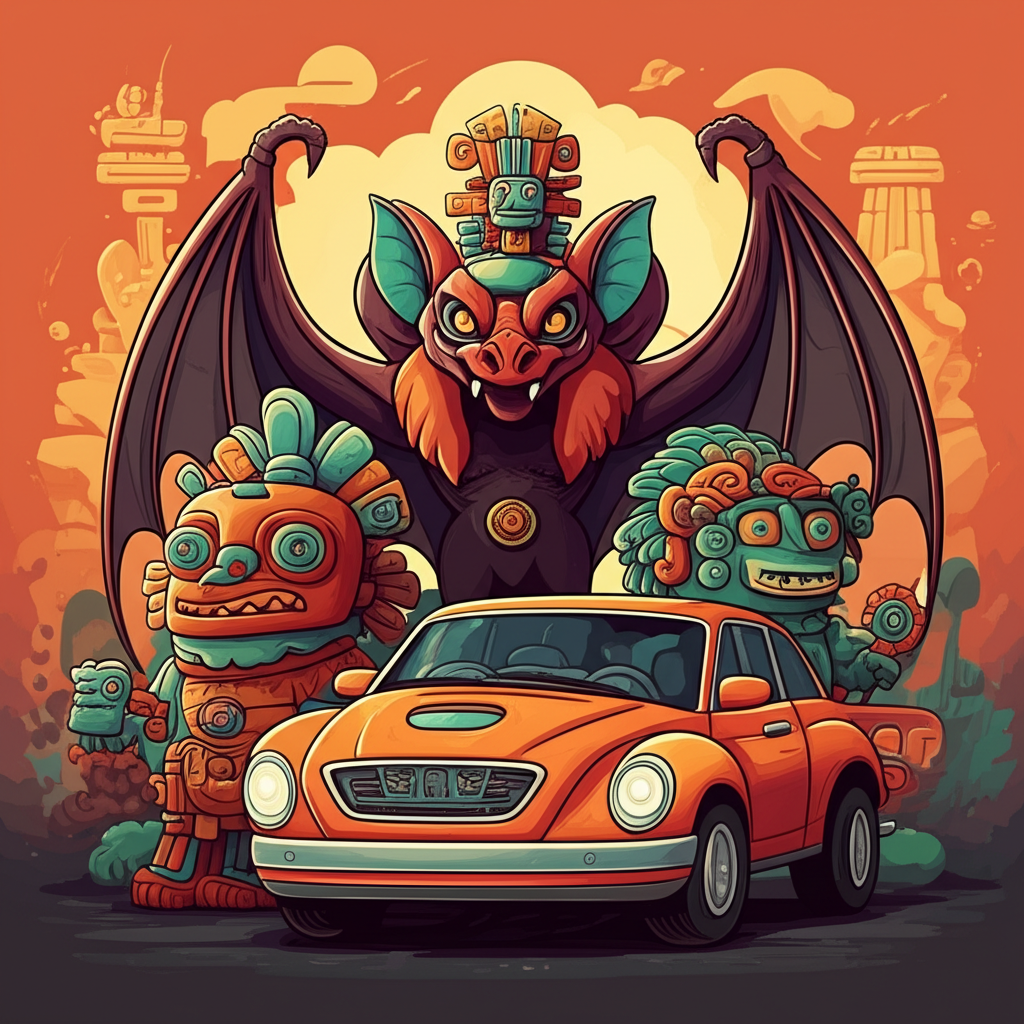
In the heart of Mesoamerica, where the vibrant tapestry of ancient civilizations bloomed, stories whispered of powerful beings and fantastical creatures that shaped the worldview of their creators. Among these captivating narratives, the legends surrounding the city of Tenochtitlan, the magnificent capital of the Aztec empire, hold a special place. These were not mere tales to pass the time; they were profound expressions of a people’s understanding of the cosmos, their fears, their hopes, and the intricate balance they perceived in the natural world. One such figure, shrouded in the darkness of the underworld, is Camazotz, the "death bat."
The origins of the Camazotz myth are deeply rooted in the rich spiritual landscape of Mesoamerica, particularly among the Maya and later influencing broader Mesoamerican mythologies, including those shared by the peoples who eventually formed the Aztec empire. The cultural era in which these stories thrived was one of complex societies, intricate religious systems, and a profound connection to the cycles of nature. For the ancient peoples of this region, the world was not a sterile, material place, but a dynamic realm alive with spiritual forces. The sun’s journey across the sky, the fertility of the earth, the ferocity of storms, and the mystery of death were all imbued with divine significance. The natural world was a constant source of inspiration and awe, and its creatures, both familiar and fearsome, were often seen as manifestations of these powerful forces, capable of influencing human destiny.
Camazotz, as depicted in these ancient narratives, is a creature of terrifying majesty. It is often described as a colossal bat, its wingspan vast enough to blot out the stars. Its eyes, in some accounts, gleamed with an infernal light, and its teeth were sharp as obsidian daggers. Beyond its physical form, Camazotz embodies the primal fear of the unknown and the inevitable embrace of death. It is a guardian of the underworld, a realm of darkness and peril, and its presence is inextricably linked to the deepest shadows. The bat itself, a nocturnal creature that navigates the darkness with uncanny precision, served as a potent symbol. Its ability to fly unseen, its eerie echolocation, and its association with caves – often seen as entrances to the underworld – made it a natural candidate for a being that dwelled in the liminal spaces between life and death.
The most prominent tale featuring Camazotz comes from the Popol Vuh, the sacred book of the K’iche’ Maya, a foundational text for understanding Mesoamerican cosmology. In this epic narrative, the hero twins, Hunahpu and Xbalanque, embark on a perilous journey into Xibalba, the Mayan underworld, to avenge their father. Xibalba is a realm of trials and tribulations, guarded by various malevolent beings. As the hero twins navigate these treacherous landscapes, they encounter Camazotz in the House of Bats. This monstrous bat, described as a creature of immense power and ferocity, attacks them relentlessly. Hunahpu, seeking refuge, foolishly peeks out from his shelter, and Camazotz swiftly decapitates him, presenting his head to the other underworld deities. Xbalanque, through cunning and courage, eventually devises a plan to overcome Camazotz and his brethren, ultimately leading to the triumph of the hero twins and their eventual ascension to the heavens.
The symbolism of Camazotz is rich and multifaceted, offering insights into the worldview of the ancient peoples who conceived it. Primarily, it represents the potent and often terrifying aspect of death. Its association with the underworld underscores the Mesoamerican understanding of death not as an end, but as a transition to another realm. Camazotz, as a guardian of this transition, embodies the fear and reverence that death inspired. Furthermore, its bat-like nature suggests a connection to the unseen forces of the night and the hidden depths of existence. The creature’s immense size and destructive potential can also be interpreted as a representation of overwhelming natural forces or the challenges that individuals must face in their spiritual journeys. For the Aztec people, who often looked to the Maya for inspiration in matters of mythology and cosmology, Camazotz likely served as a potent symbol of the dangers that lurked in the shadows, both literal and metaphorical, and the courage required to confront them.
In modern times, Camazotz continues to capture the imagination, appearing in various forms of popular culture. It has been reinterpreted in literature, often as a formidable antagonist or a symbol of primal fear. In video games, its monstrous depiction can be a challenging boss encounter, drawing on its fearsome reputation. Its image also features in artistic interpretations of Mesoamerican mythology, keeping the legend alive in visual media. These modern interpretations, while often drawing from the ancient narratives, also adapt the creature to contemporary storytelling conventions, showcasing the enduring power of its mythical archetype.
It is crucial to reiterate that the story of Camazotz is a traditional narrative passed down through generations, a testament to the rich cultural heritage of ancient Mesoamerican peoples. It reflects their unique ways of understanding the world, their artistic expressions, and their deeply held beliefs about life, death, and the cosmos. As Muslims, we recognize that only Allah (God) is the true Creator and Sustainer of all that exists. The concept of deities or supernatural beings as described in ancient myths is not in accordance with Islamic monotheism. However, these stories offer a valuable window into the human capacity for storytelling, imagination, and the creation of complex mythologies that have shaped civilizations. They remind us of the diverse ways in which humanity has sought to make sense of existence and the enduring power of narrative to connect us to our past and to the boundless realm of human creativity. The legends of guardians like Camazotz, though products of ancient imagination, continue to resonate, offering us a glimpse into the vibrant tapestry of cultural heritage and the timeless art of storytelling.



